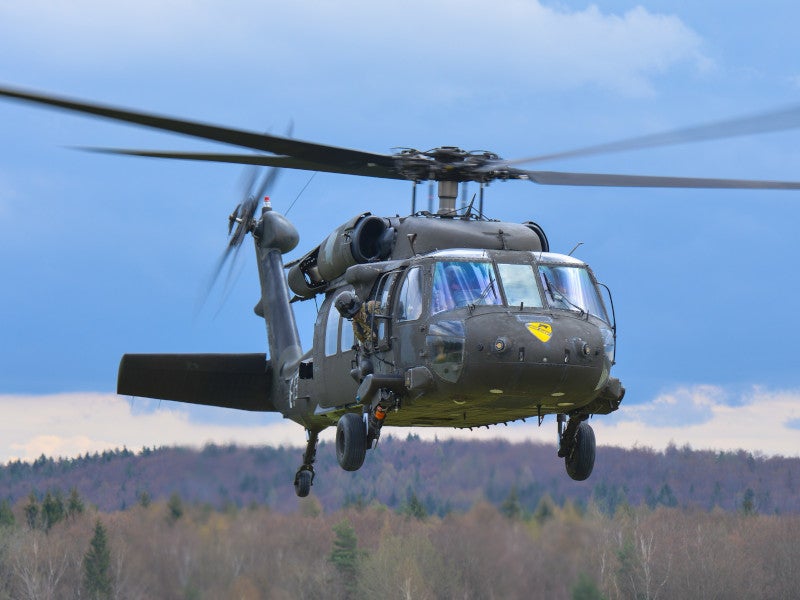Trip Ready: Making Sure Optimum Problem for Your UH 60 Helicopter
Trip Ready: Making Sure Optimum Problem for Your UH 60 Helicopter
Blog Article
Understanding the Mechanics and Design Behind Uh 60 Helicopters
The UH-60 helicopter, typically understood as the Black Hawk, stands as a peak of modern-day rotorcraft modern technology, personifying a blend of robust engineering and elaborate auto mechanics. As we peel back the layers of the UH-60's style, a globe of detailed systems and meticulous design comes to light.
Background of UH-60 Helicopters
The history of UH-60 helicopters traces back to the late 1970s when the United States Military looked for a advanced and versatile utility helicopter to change its aging fleet. In reaction to this need, the Sikorsky Airplane Firm developed the UH-60 Black Hawk helicopter. Introduced in 1979, the UH-60 swiftly ended up being a staple in military operations because of its remarkable abilities.
The UH-60 was developed to master a selection of objectives, including troop transportation, medical evacuation, digital warfare, and special procedures. Its capability to adapt to various functions made it a valuable property to the united state Army and various other military pressures all over the world
Over the years, the UH-60 platform has actually undergone numerous upgrades and variations to boost its performance and equal progressing mission demands. These helicopters have seen considerable solution in conflicts such as the Gulf Battle, Afghanistan, and Iraq, showcasing their reliability and convenience in diverse functional environments. The UH-60's abundant history is a testament to its long-lasting legacy as a top utility helicopter.

Engine and Power Solutions
Using advanced propulsion technology, UH-60 helicopters are geared up with advanced engine and power systems to ensure optimum efficiency and dependability in a series of operational scenarios. The UH-60, commonly called the Black Hawk, is powered by 2 General Electric T700-GE-701D engines, each with the ability of delivering up to 1,940 shaft horse power. These turboshaft engines offer the required drive for the helicopter to execute its goals effectively, consisting of troop transportation, clinical emptying, and fight assistance.

Blades System and Aerodynamics
How do the rotor system and aerodynamics of UH-60 helicopters contribute to their operational effectiveness and flight capacities? The rotor system of the UH-60 helicopter plays a vital duty in supplying lift and propulsion. The UH-60 features a four-bladed, completely verbalized rotor system that permits for high maneuverability and stability throughout flight. This layout enables the helicopter to execute a wide variety of goals, from transport and clinical evacuation to battle procedures.
The rules of aerodynamics also play a crucial function in the efficiency of UH-60 helicopters. The streamlined fuselage and blades blade design minimize drag, enabling the helicopter to accomplish greater rates and better gas effectiveness. The wind resistant design of the UH-60 likewise adds to its capacity to run in diverse environmental problems, consisting of warm temperature levels and high altitudes.
Avionics and Flight Control Equipment

In its elaborate coordination with the blades system and aerodynamics of UH-60 helicopters, the avionics and trip control systems create a crucial network of technologies forming the aircraft's operational capacities. In the UH-60, these systems consist of digital displays, interaction radios, General practitioner navigating, weather condition radar, and autopilot systems.
The flight control systems of the UH-60 are responsible for converting the pilot's inputs right into the proper modifications to the rotor system, making sure steady flight and ability to move. These systems contain hydraulic actuators, servos, and computers that collaborate to regulate the primary and tail blades, in addition to other trip control surface areas. By precisely taking care of the helicopter's flight dynamics, these systems make it possible for pilots to do a variety of goals, from transport and search-and-rescue to fight operations, with precision and confidence.
Function and Applications in Air Travel
The duty and applications of avionics and trip control systems in aviation are indispensable to making sure the safe and efficient procedure of airplane, including UH-60 helicopters. Avionics systems in UH-60 helicopters include a series of digital systems that aid in navigating, interaction, tracking, and controlling different aircraft functions. These systems consist of digital screens, auto-pilot systems, communication radios, general practitioner navigation devices, and climate radar. Flight control systems play an important duty in maneuvering the helicopter in the air, keeping stability, and guaranteeing specific activities. The fly-by-wire innovation made use of in modern UH-60 helicopters converts pilot inputs into electronic signals, which are then translated news by the trip control computer systems to adjust the aircraft's control surfaces. Furthermore, these systems include safety and security attributes such as autopilot modes, terrain understanding advising systems, and security enhancement systems to improve the general safety and security and functional capacities of the UH-60 helicopters in various missions, including troop transportation, clinical emptying, search and rescue, and airborne firefighting.
Conclusion
In verdict, the UH-60 helicopter is a versatile airplane with a rich history and progressed engineering. Its engine and power systems, blades system, aerodynamics, avionics, and trip control systems all work with each other to make it a reliable and reputable machine.
In its elaborate control with the rotor system and aerodynamics of UH-60 helicopters, the avionics and trip control systems create a vital network of modern technologies shaping the airplane's functional capacities.The flight control systems of the UH-60 are accountable for converting the pilot's inputs into read this post here the proper changes resource to the rotor system, guaranteeing steady trip and maneuverability. Avionics systems in UH-60 helicopters encompass a variety of digital systems that help in navigation, interaction, surveillance, and managing numerous airplane functions. In addition, these systems incorporate safety functions such as autopilot settings, terrain understanding advising systems, and stability enhancement systems to enhance the total safety and functional capacities of the UH-60 helicopters in numerous goals, consisting of army transport, clinical discharge, search and rescue, and airborne firefighting.
Its engine and power systems, rotor system, aerodynamics, avionics, and trip control systems all function with each other to make it a reputable and effective equipment.
Report this page